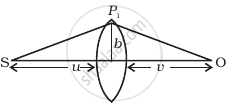Advertisements
Advertisements
Question
(i) Consider a thin lens placed between a source (S) and an observer (O) (Figure). Let the thickness of the lens vary as `w(b) = w_0 - b^2/α`, where b is the verticle distance from the pole. `w_0` is a constant. Using Fermat’s principle i.e. the time of transit for a ray between the source and observer is an extremum, find the condition that all paraxial rays starting from the source will converge at a point O on the axis. Find the focal length.

(ii) A gravitational lens may be assumed to have a varying width of the form
`w(b) = k_1ln(k_2/b) b_("min") < b < b_("max")`
= `k_1ln (K_2/b_("min")) b < b_("min")`
Show that an observer will see an image of a point object as a ring about the center of the lens with an angular radius
`β = sqrt((n - 1)k_1 u/v)/(u + v)`
Solution

(i) The time required to travel from S to P1 is `t_1 = (SP_1)/c = sqrt(u^2 + b^2)/c ≃ u/c (1 + 1/2 b^2/u^2)` assuming b << u0
The time required to travel from P1 to O is `t_2 = (P_1O)/c = sqrt(v^2 + b^2)/c ≃ v/c(1 + 1/2 b^2/v^2)`
The time required to travel through the lens is `t_1 = ((n - 1)w(b))/c` where n is the refractive index.
Thus the total time is `t = 1/c[u + v + 1/2 b^2 (1/u + 1/v) + (n - 1)w(b)]`
Put `1/D = 1/u + 1/v`
Then `t = 1/c(u + v + 1/2 b^2/D + (n - 1)(w_0 + b^2/α))`
Fermet’s principle gives
`(dt)/(db) = 0 = b/(CD) - (2(n - 1)b)/(cα)`
α = `2(n - 1)D`
Thus a convergent lens is formed if α = 2(n – 1)D. This is independent of b and hence all paraxial rays from S will converge at O (i.e. for rays b << n and b << v).
Since `1/D = 1/u + 1/v`, the focal length is D.
(ii) In this case
`t = 1/c(u + v + 1/2 b^2/D + (n - 1) k_1ln (k_2/b))`
`(dt)/(db) = 0 = b/D - (n - 1) k_1/b`
⇒ b2 = `(n - 1) k_1D`
∴ b = `sqrt((n - 1)k_1D`
Thus all rays passing at a height b shall contribute to the image. The ray paths make an angle
`β ≃ b/v = sqrt((n - 1)k_1D)/v^2 = sqrt(((n - 1)k_1uv)/(v^2(u + v))) = sqrt(((n - 1)k_1u)/((u + v)v))`.
APPEARS IN
RELATED QUESTIONS
In motor vehicles, a convex mirror is attached near the driver's seat to give him the view of the traffic behind. What is the special function of this convex mirror which a plane mirror can not do?
If an object far away from a convex mirror moves towards the mirror, the image also moves. Does it move faster, slower or at the same speed as compared to the object?
In image formation from spherical mirrors, only paraxial rays are considered because they
Light is incident from glass (μ = 1.5) to air. Sketch the variation of the angle of deviation δ with the angle of incident i for 0 < i < 90°.
Focal length of a mirror is given by ______.
According to the mirror equation, ______.
A short object of length L is placed along the principal axis of a concave mirror away from focus. The object distance is u. If the mirror has a focal length f, what will be the length of the image? You may take L << |v – f|.
A concave mirror of focal length 12 cm forms three times the magnified virtual image of an object. Find the distance of the object from the mirror.
If an object is placed at a distance of 10 cm in front of a concave mirror of a focal length of 20 cm, the image formed will be ______.
Why does a car driver use a convex mirror as a rear-view mirror?
